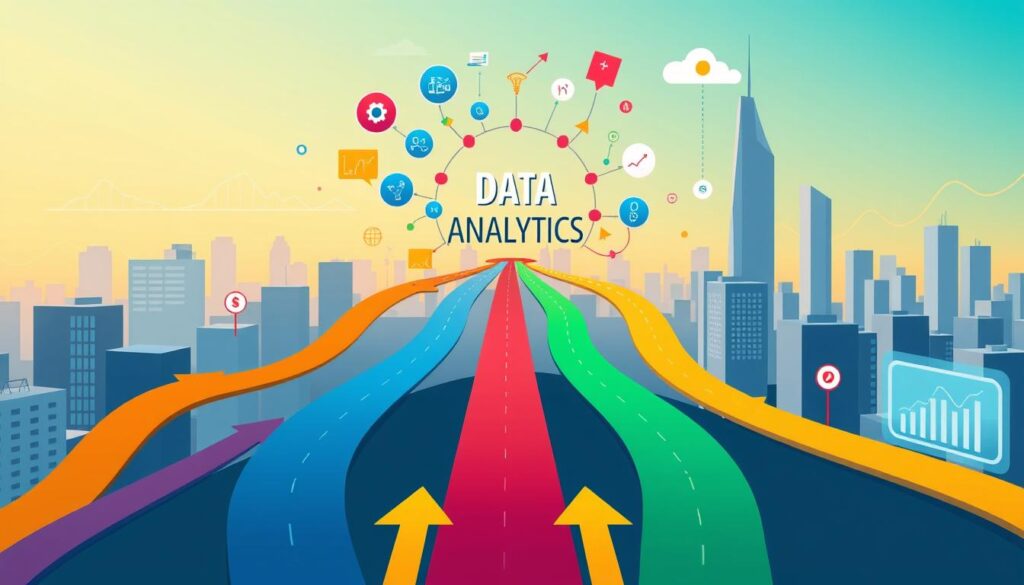Data Analytics is a field that’s growing fast and needs more skilled people. It’s a great career choice for those who love working with data. Companies want experts who can understand and use data to make smart business decisions.
From my own experience, I know that getting good at Data Analytics can really help your career. It lets you move into new jobs or get ahead in your current one. To succeed, you need to know a lot about programming, data tools, and statistics.
Key Takeaways
- Data Analytics is a rapidly growing field with high demand for skilled professionals.
- Mastering Data Analytics can be a career breakthrough, enabling individuals to transition into new roles or advance in their current careers.
- Proficiency in programming languages, data visualization tools, and statistical analysis is essential for a successful Data Analytics Career.
- Data Analysis and Career Development are closely linked, as data-driven decision making becomes increasingly important in today’s business landscape.
- The Data Analytics Career path offers various job opportunities, including roles such as Business Intelligence Analyst, Data Scientist, and Marketing Analyst.
Understanding Modern Data Analytics Landscape
Exploring the world of data analytics, I see how vital Data Visualization is. The field is changing fast, with new tools and tech popping up daily. To keep up, knowing the latest trends is key, like big data, machine learning, and AI.
The need for data analysts is growing, with jobs in finance, healthcare, and e-commerce. To succeed, one needs skills in programming, Data Visualization tools, and stats. Business Intelligence is also important, helping companies make smart choices based on data.
Here are some essential skills for data analysts:
- Knowing programming languages like Python and R
- Understanding databases and tools, such as SQL, Hadoop, and Spark
- Being good at Data Visualization with tools like Tableau and Power BI
- Having Business Intelligence and domain knowledge for insights
- Skills in Data Science, including machine learning and stats
By honing these skills and keeping up with trends, data analysts can fully use Data Science. This leads to business growth through smart decisions.
Introducing Advanced Analytics Tools for Professionals
As a professional, I know how key data-driven decision making is for business growth. It’s vital to use analytics tools to shape business strategies. Tools like Excel, SQL, and Python are vital for those aiming to become data analysts or grow in their careers.
Some top analytics tools include:
- Microsoft Excel, with over 750 million users worldwide
- Python, ranked as the number one programming language for data analysis
- R, with a library of over 10,000 packages available through the CRAN
These tools help data analysts work with complex data. They offer insights that guide business strategies and boost professional growth. By using these analytics tools, professionals can make data easier to understand. This leads to smarter data-driven decision making.
| Analytics Tool | Description |
|---|---|
| Google Data Analytics Professional Certificate | Includes training in tools like spreadsheets, SQL, and Tableau for preparation for entry-level data jobs |
| RapidMiner | Data mining software that automates the process of identifying patterns and trends within data |
| Tableau | Leading data visualization software with capabilities for connecting to hundreds of different data sources |
Key Features and Capabilities
Exploring data analytics, I see how vital key features and capabilities are. They help professionals grow in their careers. Data analysis is key to business intelligence and career advancement. With more companies needing data-driven decisions, they look for those who can use data tools to grow their business.
Some important features of data analytics tools include:
- Data visualization tools like Tableau and Power BI help present findings well.
- Predictive analytics let professionals forecast future trends.
- Integration capabilities combine data from different sources for a complete business view.
These features are vital for those aiming to become data analysts or move up in their careers. Using data tools and techniques, professionals can uncover valuable insights. This leads to better decisions and business success. So, data analysis is a key part of business intelligence and career growth.
The U.S. Bureau of Labor Statistics says the data analyst job market will grow by 23% by 2032. This shows the growing need for data analysis skills. By improving these skills and keeping up with trends, professionals can thrive in this fast-changing field.
| Job Title | Projected Growth Rate |
|---|---|
| Data Analyst | 23% |
| Operations Research Analyst | 25% |
| Market Research Analyst | 22% |
Data Analytics Career Pathways and Growth
As a data analyst, I’ve seen how key Career Development and Professional Growth are in data analytics. With more companies needing Data-Driven Decision Making, they look for experts in data analytics to boost their business.
Data analysts have many career paths to choose from. You can move into roles like data scientist, business analyst, or data engineer. Data analysts earn an average of $71,993. Senior analysts can make up to $95,902.
With more experience and certifications, you can become an analytics manager or director. These roles come with salaries from $126,541 to $168,145.
The following table shows average salaries for different data analytics roles:
| Role | Average Salary |
|---|---|
| Data Analyst | $71,993 |
| Senior Data Analyst | $95,902 |
| Analytics Manager | $126,541 |
| Director of Analytics | $168,145 |

Practical Applications in Real-world Scenarios
In the world of data analytics, I’ve seen how Data Analysis changes business decisions. Business Intelligence and Analytics Tools help companies grow, work better, and make customers happier. For example, Netflix and Amazon boost sales by 20-35% thanks to analyzing what users like.
In healthcare, Analytics Tools help make patients better by checking new treatments. They also figure out when it’s busiest, so doctors and supplies are ready. Here are some ways Data Analysis and Business Intelligence are used:
- Retail analytics guess what people will buy, check how loyal customers are, and arrange stores better to make smart choices and cut risks.
- E-commerce analytics look at things like how often visitors come back, how much they spend over time, and how long they stay on websites to see if designs and ads work.
- Marketing analytics are key for marketing firms, studying what customers want, how well ads do, and how people interact on social media.
Using Analytics Tools and Business Intelligence helps professionals grow businesses and make better choices. As data analytics keeps getting better, it’s important to keep learning about new trends and tools to stay ahead.
Professional Development Through Analytics Tools
As a data analyst, I know how vital Career Development and Professional Growth are. To keep up, using analytics tools and methods is key. This helps make Data-Driven Decision Making better. The data analytics program at Johns Hopkins shows how to improve skills and knowledge.
Some important areas for growth in data analytics include:
- Learning essential skills like SQL, Tableau, and R programming
- Getting certifications, like the Google Data Analytics Certificate
- Getting recognized in the industry, leading to jobs in big tech companies
Investing in growth helps data analysts move up and grow businesses. With more jobs needing data skills, it’s key to focus on Career Development and Professional Growth.

| Certification | Completion Time | Estimated Study Time |
|---|---|---|
| Google Data Analytics Certificate | Less than six months | Under 10 hours per week |
| Google Business Intelligence Certificate | Less than two months | Under 10 hours per week |
Investment and ROI Considerations
Exploring data analysis, I see how vital investment and ROI are. It’s key for business intelligence and career growth. The ROI formula is simple: ROI = Value Generated / Investment. But for data analysis, we use a more detailed formula: Data ROI = (Data product value – Data downtime) / Data investment.
Business intelligence features can bring big returns, from 250% to 2600%. Improving pricing and customer satisfaction also leads to high ROIs, like 13,750% and 1000%. These show the worth of investing in data analysis and business intelligence.
When looking at investment and ROI, we must think about a few things:
- Value generated by data analysis
- Cost of data investment
- Data downtime and its impact on ROI
- Comprehensive data ROI formula
By weighing these factors, professionals can make smart choices. This helps in career growth and business success.
Conclusion: Transforming Your Career Through Data Analytics
Data analytics is changing the game. The global market is expected to jump from $7.03 billion in 2023 to $303.4 billion by 2030. This growth means more jobs for data analysts, with a 27.6% annual increase.
Learning to use data analytics tools opens doors to new career paths. You can start as a data analyst and move up to data scientist or architect. This field offers many chances to grow professionally.
By 2025, we’ll see over 463 exabytes of data every day. This demand for data experts will keep rising. Investing in your skills in data analytics can lead to lasting success and help transform businesses.



